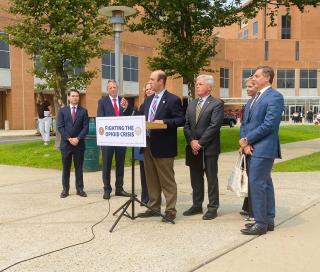Suffolk County Executive Steven Bellone joined Nassau County Executive Laura Curran at the Central Islip Courthouse Tuesday, July 20 to announce a settlement partnered with New York Attorney General Letitia James; an agreement with McKesson Corporation, Cardinal Health, Inc., and AmerisourceBergen Drug Corporation, three of the nation’s largest drug distributors, will deliver up to $1.1 billion to New York State to combat the ongoing opioid epidemic.
For Suffolk County, it will mean between $80 and $100 million, said Legis. Rob Calarco, who was the first to lead Long Island’s lawsuits against the opioid companies.
“They’ll be upfront payments of $20 million and the remainder will be paid over a period of 20 years,” Calarco said. “This is the largest settlement in the country for the opioid lawsuits. They were active litigants in Supreme Court and will no longer be a party to the lawsuit and we will drop our action with them.
“What we’re starting to see as we have been making our case in court about how these companies pursued profits knowing that these drugs were dangerous, we had a strong case and it was in their best interest to settle.”
The county announcement comes on the heels of settlement agreements with several defendants in the county’s pending opioid litigation reached last week. They included Rite Aid offering $1.5 million; CVS offering $3.5 million, plus an additional $500,000 if certain settlements are reached with other defendants; Walmart offering $3.062 million; Walgreens offering $5 million; and J & J offering between $8.4 million and $19.8 million over the next 10 years to be used for restitution and abatement.
J & J also agreed to stop manufacturing, selling or promoting opioids going forward.
Legis. Rob Calarco (D-Patchogue) spearheaded the lawsuits, introducing a resolution in October 2014 leading to the county attorney’s office commencing a lawsuit against drug companies who develop opioid painkillers; the Long Island Advance broke the story that year.
Orange and Santa Clara counties in California as well as the city of Chicago had already led the way that summer in separate lawsuits alleging “aggressive marketing” by five companies that had caused an additional epidemic.
“This is the first jury trial on this issue in the nation,” said Calarco of the trial being held at Touro Law School in Bay Shore.
Calarco recently sat with the Long Island Advance and answered questions on these momentous legal decisions:
Long Island Advance:
What one thing made you introduce the county lawsuit against the opioid companies? Was it the 2011 Father’s Day murders when David Laffer, 33, walked into Haven Drugs in Medford on Father’s Day to rob oxycodone and other painkillers for his wife, Melinda Brady, and shot and killed four people?
Rob Calarco: Certainly, it was the murders; that was part of it. (Calarco was Legis. Jack Eddington’s chief of staff at the time in Patchogue.) But also, I spoke to a lot of constituents and their stories were so similar—that whoever in their life who wound up addicted, started with a legal prescription. It was the kid playing football, a wife or a husband in an accident. So often it was prescription medication for opioid drugs. And we needed to come to the realization that the problem came from the drug companies pushing their products.
LIA: How will the settlements work?
RC: In regards to the four pharmacies, those settlements are strictly between Nassau and Suffolk counties. Each of us will receive money, as announced, within 21 days from the date the paperwork is settled. There are attorney fees that will be paid from us (Simmons Hanly Conroy LLC was retained); they’re entitled to 25 percent of the settlements. The checks will probably be sent to the comptroller’s office.
LIA: What about Purdue Pharma L.P., its general partner Purdue Pharma Inc., and Purdue Pharma L.P.’s direct and indirect subsidiaries who filed a voluntary petition for bankruptcy relief under Chapter 11? (County claims against them are $10.4 million and $19.6 million over nine years to be used for abatement.)
RC: The global bankruptcy plan is between $4 billion and $6.5 billion and that still needs to be approved by the bankruptcy judge. We signed on as an entity. I think by early next year, they’ll be making settlements. The Sacklers heading the company will sell it, so whoever buys it will determine the settlement of the bankruptcy plan. In some ways, I think Purdue Pharma and the owners are getting off easy. They pulled every dollar out when they saw the writing on the wall and put it in offshore accounts. The federal bankruptcy judge required the Sackler family heading the company to have some responsibility, and they will pay some money to the bankruptcy plan.
LIA: How will the county then direct the money received?
RC: From what I’m hearing, the state will set some parameters. There’s going to be some structure so that the money will be utilized for specific expenses. I suspect we’ll use partners we already have providing programs that will be effective.
LIA: J & J agreed not to manufacture, sell or promote opioids going forward. Was that a surprise?
RC: Was I surprised at their decision to get out of the game? Yes. Purdue won’t be promoting those drugs, either. After bankruptcy, they’ll be producing medications addressing addictions. Opium was regularly prescribed at the end of the 19th century, but eventually doctors recognized the harm they were causing with addictions then, so this isn’t new. There are legitimate medical uses for opioids. Historically, they dealt with palliative care and end of life to make sure the quality of life of the person was eased because they weren’t going to live long. Also, it can be prescribed for short-term relief, maybe a day or two after specific surgeries. But it’s another thing when a 30-day prescription is being dispensed. You can talk to our health commissioners; at the time, these pharmaceuticals were being pushed. The companies were hiring doctors and funded not-for-profits to train doctors to use them. And they were being told this was the best way and if they refused, they could be sued. One of the issues they created was pseudo-addiction: we need to up the dosage. This is a new scourge. We’re in court right now with three of the other manufacturers and those responsible for distribution, because the pharmacists had a responsibility to stay on top of how many opioid prescriptions were being prescribed and how often. That’s why they’re a party to the lawsuit. They had no problem jumping on the bandwagon and making a profit.
LIA: What could they have done?
RC: They should have been concerned when there was an unusually large volume being prescribed and notified the DEA [U.S. Drug Enforcement Administration]. The state created I-STOP. (Days before the Father’s Day murders took place in Medford, then-New York State attorney general Eric Schneiderman announced the Internet System for Tracking Over-Prescribing Act prescription monitoring program; it provided health care practitioners and pharmacists with centralized information to avoid overprescribing.) They upload who the doctor is, what the prescription is and the amount, and where it’s being filled. That’s real-time reporting and it was effective in curbing the problem. When prescription drugs got harder, people addicted went to using heroin. It’s much purer and can be ingested without needles.

